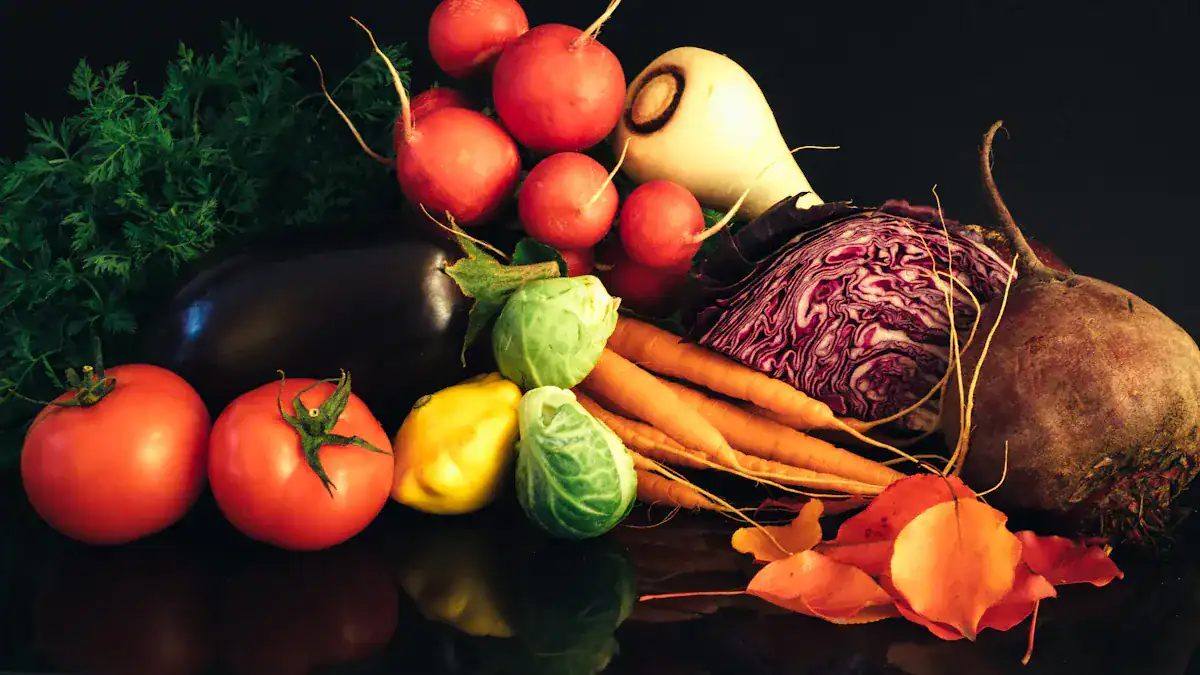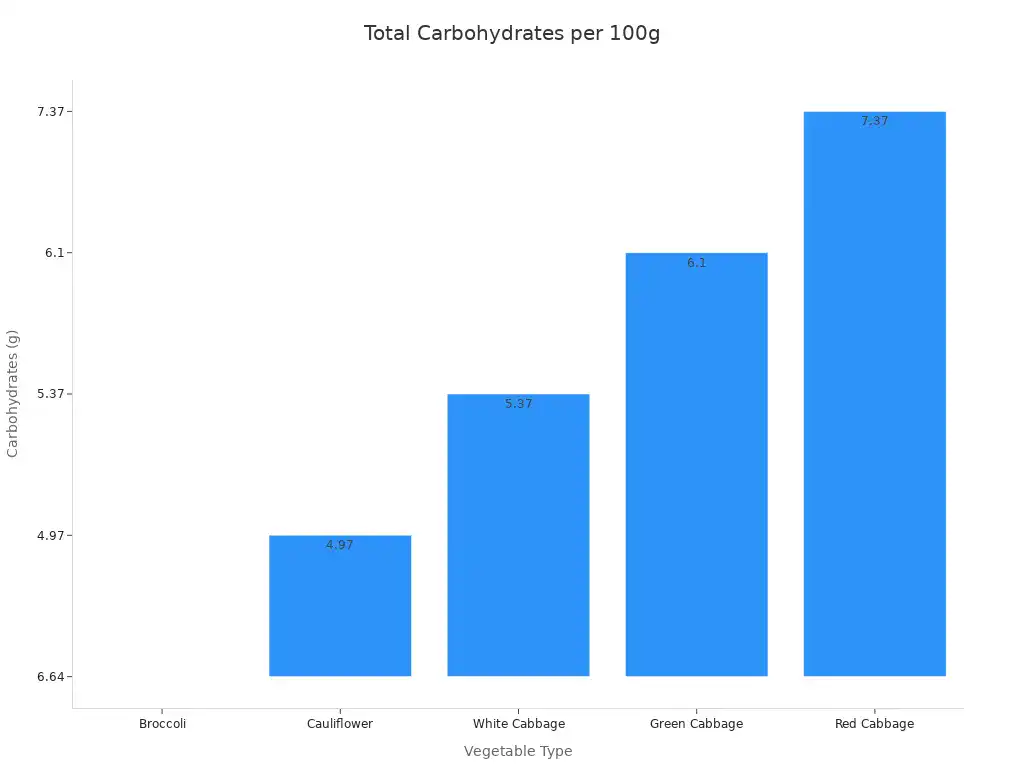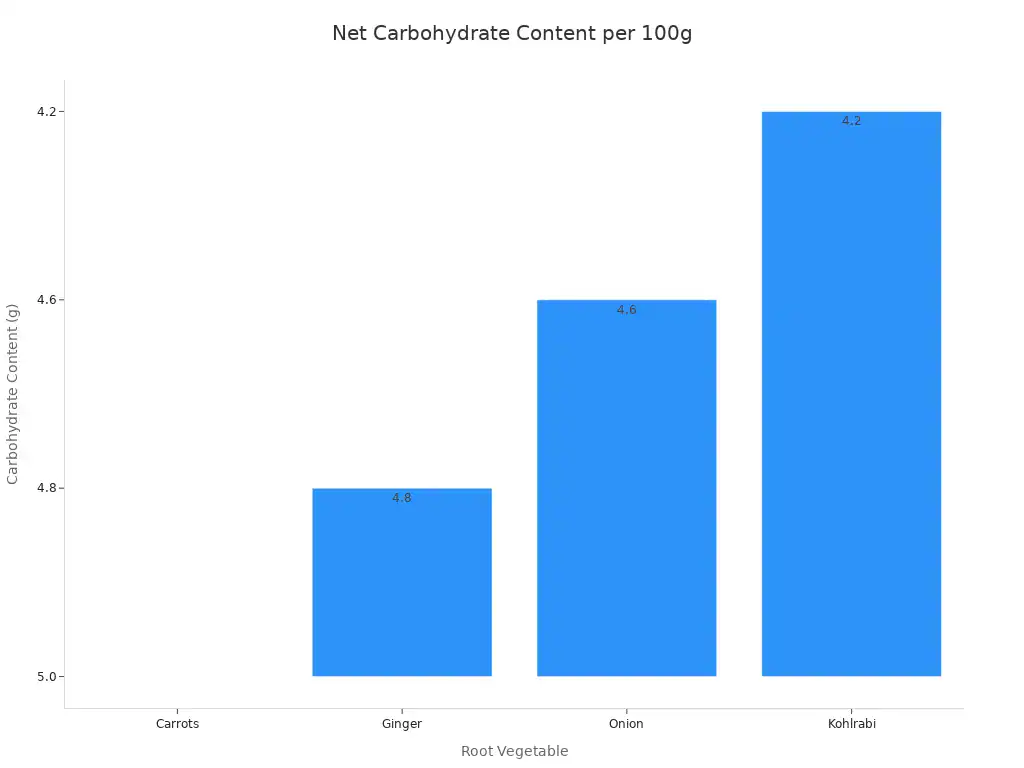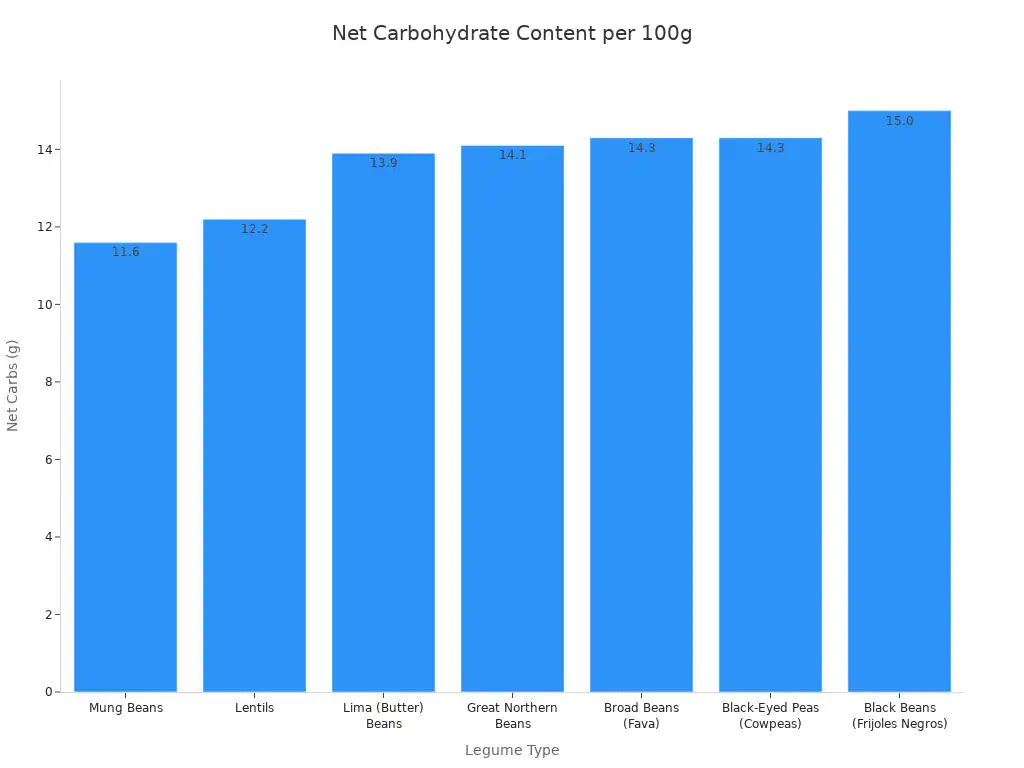
Vegetables contain varying amounts of carbohydrates. Understanding their carbohydrate content is crucial for your dietary goals. You need this information whether you follow a low carb diet, a specific low carb eating plan, or simply aim for general health. Knowing your vegetable carbs helps you make informed carbohydrate choices. This guide simplifies information about both total and net carbs, empowering you to choose wisely.
Key Takeaways
Understand the difference between total carbs and net carbs. Net carbs are what your body uses for energy.
Choose low-carb vegetables like leafy greens and broccoli. They are good for managing your carb intake.
Eat moderate-carb vegetables like carrots and squash in smaller amounts. This helps you stay within your carb goals.
Limit high-carb vegetables such as potatoes and corn. They have many carbs and can quickly add up.
Cooking methods can change how your body uses carbs. Boiling can lower the sugar impact of some vegetables.
Understanding Vegetable Carbs

Net Carbs vs. Total Carbs
You often hear about “net carbs” and “total carbs.” It is important to know the difference. Total carbohydrates include all types of carbohydrates. This means starches, dietary fiber, and sugars.
Net carbs are different. You calculate net carbs by subtracting fiber and sugar alcohols from total carbohydrates. This is because your body does not fully digest fiber. Sugar alcohols also have little impact on your blood sugar.
However, you should know that “net carbs” is not an official scientific term. Food companies often use it as a marketing tool. The FDA has not evaluated claims made outside the Nutrition Facts label. The science behind these claims can be unclear. Still, net carbs represent the carbohydrates your body actually digests and uses for energy.
Why Vegetable Carbs Matter
They also drive your insulin response. This can affect fat storage or inflammation. Total carbs include fiber, which your body does not digest. Fiber does not significantly affect your blood sugar levels.
Knowing the difference helps you make smart carbohydrate choices. This is especially true if you follow a low-carb diet. You can choose vegetables that have fewer net carbs. This helps you manage your daily carb intake. Understanding your vegetable carbs empowers you to pick the best options for your health goals.
Low-Carb Vegetables

You can enjoy many vegetables freely on a low carb diet. These are typically under 5 grams of net carbs per 100 grams. Vegetables that grow above ground generally have fewer carbs. You can often eat these low carb vegetables in larger amounts.
Leafy Greens
Leafy greens are excellent choices for managing your carbohydrate choices. They offer very few net carbs. For example, raw spinach contains only 1 gram of net carbs per 100 grams.
Raw kale has 1.4 grams of carbohydrates per cup. Shredded raw romaine lettuce provides 1.6 grams of carbohydrates per cup. Other great options include:
Radicchio: 0.8g net carbs per 100g
English Spinach: 0.7g net carbs per 100g
Bok Choy: 0.6g net carbs per 100g
Alfalfa Sprouts: 0.5g net carbs per 100g
Curly Endive: 0.4g net carbs per 100g
Cruciferous Vegetables
Cruciferous vegetables are another group of fantastic low carb vegetables. Broccoli, cauliflower, and cabbage are versatile and nutrient-dense. They provide many health benefits beyond their low carb count. These vegetables are rich in vitamins like K, A, and C. They also contain beneficial compounds such as glucosinolates. These compounds may help protect against certain diseases.
Cruciferous Vegetable | Total Carbohydrates (g per 100g) |
|---|---|
Broccoli | 6.64 |
Cauliflower | 4.97 |
White Cabbage | 5.37 |

Non-Starchy Vegetables
Many other non-starchy vegetables fit perfectly into a low-carb eating plan. These include cucumber, zucchini, bell peppers, and asparagus. These non-starchy vegetables add flavor and nutrients to your meals without significantly increasing your carb intake.
Low-Carb Vegetable Nutrition Chart
Here is a quick reference for some common low-carb vegetables:
Vegetable | Total Carbs (per 100g) | Net Carbs (per 100g) |
|---|---|---|
Iceberg lettuce | 2.97g | (approx. 1.97g) |
Spinach | 3.63g | 1g |
Broccoli | 6.64g | (approx. 4.24g) |
Cauliflower | 4.97g | (approx. 2.97g) |
White Cabbage | 5.37g | (approx. 3.37g) |
Note: Net carb values for some vegetables are estimated by subtracting typical fiber content.
Moderate-Carb Vegetables
Some vegetables have a moderate amount of carbohydrates. These vegetables typically contain 5 to 15 grams of net carbs per 100 grams. You can still enjoy these vegetables. You might need to watch your portion sizes, especially if you follow a strict low-carb diet.
Root Vegetables
Root vegetables grow below the ground. They often have more carbohydrates than above-ground vegetables. Carrots, onions, and beets are common examples. You can include them in your meals.
Here are some common root vegetables and their net carbohydrate content:
Root Vegetable | Carbohydrate Content (g per 100g) |
|---|---|
Carrots | 5.0 |
Ginger | 4.8 |
Onion | 4.6 |
Kohlrabi | 4.2 |

Squashes
Squashes offer a range of carbohydrate content. Summer squashes like crookneck and straightneck varieties are lower in carbs. Canned, drained summer crookneck and straightneck squash contains 2 grams of net carbohydrates per 100g serving. Patty-pan squash, another summer type, has 2.5 grams of net carbohydrates per 100g serving.
Winter squashes, such as butternut squash and acorn squash, have more carbs.
Type of Squash | Total Carbs (g) per 100g | Net Carbs (g) per 100g |
|---|---|---|
Winter squash (general category, includes butternut) | 8.9 | 6.1 |
Acorn squash (calculated from 205g serving) | 14.63 | 10.24 |
Legumes
Legumes are another group of moderate-carb vegetables. Green beans and peas are popular choices. They have more carbs compared to leafy greens. You should control your portions if you are on a strict low-carb plan. Green beans have 3.6 grams of net carbs per 100g. Peas contain about 10 grams of net carbs per 100g.
Many other legumes also fit into this category. For example, mung beans have 11.6g net carbs per 100g. Lentils contain 12.2g net carbs per 100g. Broad beans and black-eyed peas both have 14.3g net carbs per 100g. You can make informed carbohydrate choices by knowing these values.
Legume | Net-carbs per 100g |
|---|---|
Mung Beans | 11.6g |
Lentils | 12.2g |
Broad Beans (Fava) | 14.3g |
Black-Eyed Peas (Cowpeas) | 14.3g |

Moderate-Carb Vegetable Nutrition Chart
Vegetable | Total Carbs (per 100g) | Net Carbs (per 100g) |
|---|---|---|
Carrots | 9.58g | 5.0g |
Onion | 9.34g | 4.6g |
Beets | 9.96g | 7.7g |
Green Beans | 7g | 3.6g |
Peas | 14.46g | 10g |
Butternut Squash | 8.9g | 6.1g |
Acorn Squash | 14.63g | 10.24g |
Higher-Carb Vegetables
Some vegetables contain a higher amount of carbohydrates. These vegetables typically have over 15 grams of net carbs per 100 grams. You will generally avoid or limit these on strict low-carb diets. They can quickly add up to your daily carbohydrate limit.
Starchy Vegetables
Starchy vegetables are the main group in this category. Potatoes, sweet potatoes, and corn are common examples. These vegetables provide significant energy due to their higher carbohydrate content. You might find them in many traditional meals. However, their carb count makes them less suitable for very low-carb eating plans.
Sweet potatoes and potatoes both contain approximately 21 grams of carbohydrates per 100-gram serving. This includes both total and net carbs. You need to consider these numbers when making your carbohydrate choices. For instance, white potatoes have about 18.8 grams of net carbs per 100 grams. Sweet potatoes offer around 17.1 grams of net carbs for the same serving size. These starchy vegetables can quickly impact your daily carb intake.
Here is a look at the carbohydrate content of various starchy vegetables:
Type of Potato | Total Carbs (g) | Net Carbs (g) |
|---|---|---|
White Potatoes | 21 | 18.8 |
Russet Potatoes | 18 | 16.7 |
Red Potatoes | 15.9 | 14.2 |
Sweet Potatoes | 20.1 | 17.1 |
Yellow Potatoes | 17.57 | 16.17 |
Carisma Potatoes | 10.03 | 8.7 |

Corn is another example of a starchy vegetable with a higher carb count. A 100-gram serving of sweet yellow corn contains about 19 grams of total carbohydrates and roughly 16 grams of net carbs. You should consume these vegetables in moderation if you follow a low-carb diet.
Higher-Carb Vegetable Nutrition Chart
This chart provides a quick overview of some higher-carb vegetables:
Vegetable | Total Carbs (per 100g) | Net Carbs (per 100g) |
|---|---|---|
White Potatoes | 21g | 18.8g |
Sweet Potatoes | 20.1g | 17.1g |
Sweet Yellow Corn | 19g | 16g |
Incorporating Vegetable Carbs
You understand the different carbohydrate levels in vegetables. Now, you can learn how to use this knowledge in your daily meals. This helps you meet your dietary goals.
Meal Planning for Low-Carb Diets
You can create balanced meals when you follow a low carb diet. Combine protein, healthy fats, and low-carb vegetables. Experiment with herbs and spices. This enhances flavor without adding carbs. You can also prepare meals in advance. Batch-cooking or making salads saves you time.
Consider these low-carb vegetables for your meals:
Leafy greens like spinach and kale offer iron and vitamins.
Cruciferous vegetables such as broccoli, cauliflower, and Brussels sprouts provide fiber.
Zucchini and bell peppers add bulk and fiber with minimal carbs.
Here is a sample meal plan to guide your low carb eating plan:
Day | Lunch | Dinner |
|---|---|---|
Monday | Grilled chicken salad with mixed greens, cucumber, bell peppers, and a vinaigrette dressing. | Baked salmon with roasted asparagus and cauliflower rice. |
Tuesday | Tuna salad (made with avocado mayo) served in lettuce cups with cherry tomatoes. | Beef stir-fry with broccoli, snap peas, and mushrooms (use tamari or coconut aminos for sauce). |
Balancing Carbs for General Health
You do not always need a strict low-carb approach. You can balance your carbohydrate choices for general health. The Dietary Guidelines for Americans recommend that 45% to 65% of your daily calories come from carbohydrates. The World Health Organization (WHO) advises that carbohydrates should primarily come from whole grains, vegetables, fruits, and pulses.
This table shows recommended daily intake:
Macronutrient | Recommended Daily Intake (% of total calories) |
|---|---|
Carbohydrates | 45% to 65% |
Fat | 20% to 35% |
Protein | 10% to 35% |
Cooking Methods and Carb Impact
Cooking methods can change the impact of vegetable carbs. For example, boiling sweet potatoes results in lower glycemic index (GI) values. This happens compared to frying, baking, or roasting. Boiling changes starch structure. It also retains resistant starches. These are less digestible.
Boiling, when done correctly, can reduce the glycemic impact. It preserves fiber.
Baking and roasting can modify carbohydrate structures. This potentially lowers their glycemic impact. It also enhances flavors.
However, baking and roasting can increase the glycemic index of starchy foods like potatoes. This is due to higher temperatures and longer cooking times.

You now understand the varying carbohydrate content in vegetables. This knowledge empowers you to make informed food choices for your dietary planning and overall health. Fiber-rich carbohydrates, common in vegetables, increase satiety, aiding weight management, and reduce the risk of chronic diseases.
They also support a healthy gut. Use the provided lists and charts as practical resources. They help you navigate vegetable carbs in your daily meals, emphasizing both total and net carbs.



